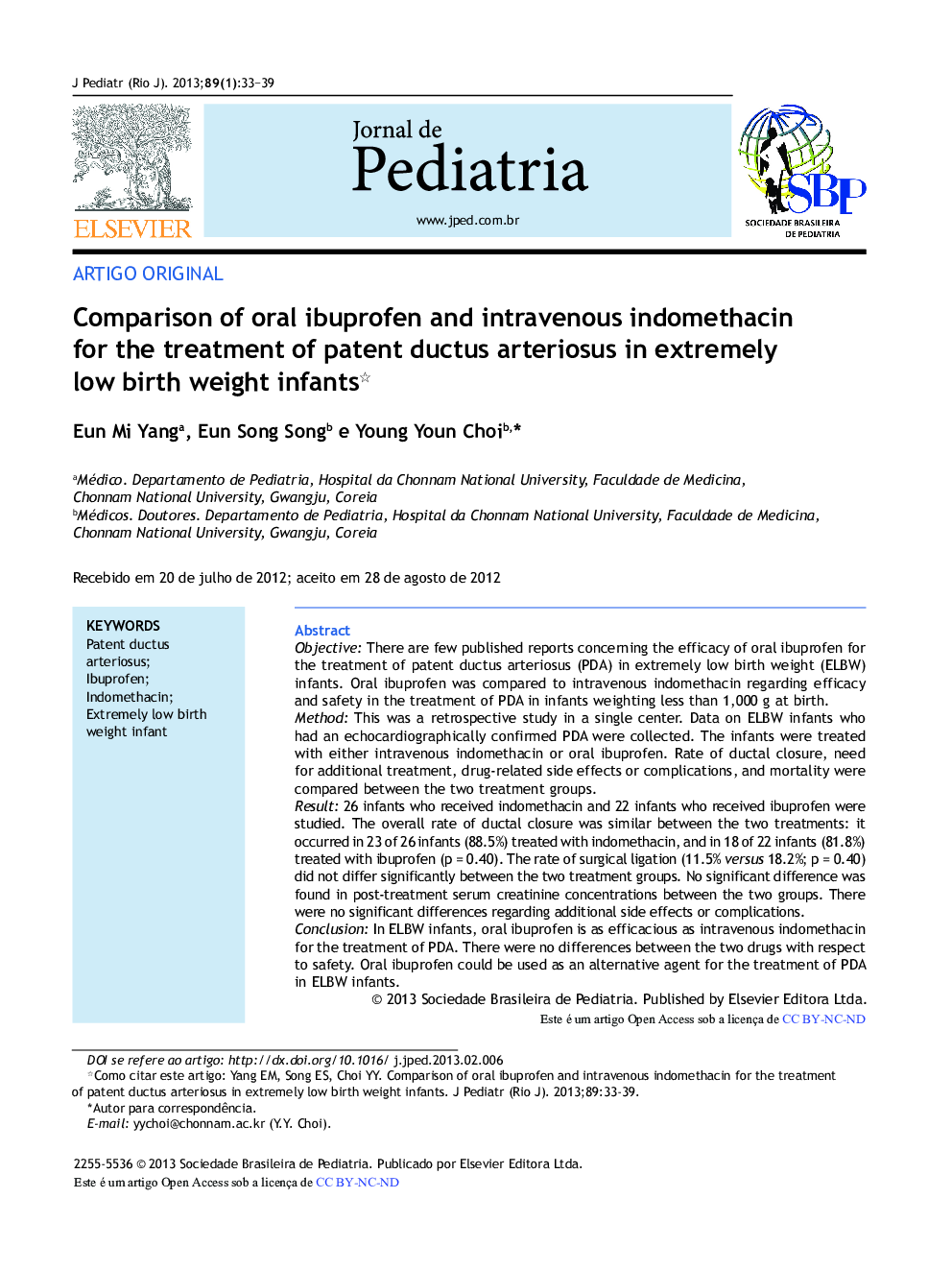| کد مقاله | کد نشریه | سال انتشار | مقاله انگلیسی | نسخه تمام متن |
|---|---|---|---|---|
| 4154647 | 1273722 | 2013 | 7 صفحه PDF | دانلود رایگان |

ObjectiveThere are few published reports concerning the efficacy of oral ibuprofen for the treatment of patent ductus arteriosus (PDA) in extremely low birth weight (ELBW) infants. Oral ibuprofen was compared to intravenous indomethacin regarding efficacy and safety in the treatment of PDA in infants weighting less than 1,000 g at birth.MethodThis was a retrospective study in a single center. Data on ELBW infants who had an echocardiographically confirmed PDA were collected. The infants were treated with either intravenous indomethacin or oral ibuprofen. Rate of ductal closure, need for additional treatment, drug-related side effects or complications, and mortality were compared between the two treatment groups.Result26 infants who received indomethacin and 22 infants who received ibuprofen were studied. The overall rate of ductal closure was similar between the two treatments: it occurred in 23 of 26 infants (88.5%) treated with indomethacin, and in 18 of 22 infants (81.8%) treated with ibuprofen (p = 0.40). The rate of surgical ligation (11.5% versus 18.2%; p = 0.40) did not differ significantly between the two treatment groups. No significant difference was found in post-treatment serum creatinine concentrations between the two groups. There were no significant differences regarding additional side effects or complications.ConclusionIn ELBW infants, oral ibuprofen is as efficacious as intravenous indomethacin for the treatment of PDA. There were no differences between the two drugs with respect to safety. Oral ibuprofen could be used as an alternative agent for the treatment of PDA in ELBW infants.
ResumoObjetivoExistem poucos relatórios publicados com relação à eficácia do ibuprofeno via oral no tratamento da persistência do canal arterial (PCA) em neonatos com extremo baixo peso ao nascer (EBPN). Comparamos o ibuprofeno via oral à indometacina intrave- nosa no que diz respeito à eficácia e segurança no tratamento de PCA em neonatos com peso inferior a 1.000 g ao nascer.MétodoEste foi um estudo retrospectivo em um único centro. Coletamos dados de neo- natos com EBPN que tiveram PCA ecocardiograficamente confirmada. Os neonatos foram tratados tanto com indometacina intravenosa quanto com ibuprofeno via oral. A taxa de fechamento do canal, a necessidade de tratamentos adicionais, os efeitos colaterais ou as complicações relacionadas ao medicamento e a mortalidade foram comparados entre os dois grupos de tratamento.ResultadoExaminamos 26 neonatos que receberam indometacina e 22 que receberam ibuprofeno. A taxa geral de fechamento do canal foi semelhante nos dois tratamentos: o fechamento do canal ocorreu em 23 dos 26 neonatos (88,5%) no grupo indometacina, e em 18 dos 22 neonatos (81,8%) no grupo ibuprofeno (p = 0,40). A taxa de ligadura cirúr- gica (11,5% em comparação a 18,2%; p = 0,40) não diferiu de forma significativa entre os dois grupos de tratamento. Após o tratamento, não foi encontrada nenhuma diferença significativa nas concentrações de creatinina sérica entre os dois grupos. Não houve dife- renças significativas com relação a efeitos colaterais ou complicações adicionais.ConclusãoEm neonatos com EBPN, o ibuprofeno via oral é tão eficaz quanto a indome- tacina intravenosa no tratamento da PCA. Não há diferenças entre os medicamentos no que diz respeito à segurança. O ibuprofeno via oral poderia ser usado como um agente alternativo no tratamento da PCA em neonatos com EBPN.
Journal: Jornal de Pediatria (Versão em Português) - Volume 89, Issue 1, January–February 2013, Pages 33-39